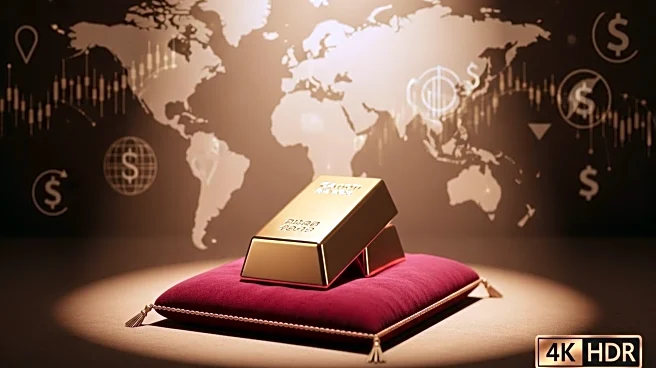What's Happening?
Gold prices have surged past the $4,000 per ounce mark for the first time, driven by a combination of global economic uncertainties and expectations of U.S. interest rate cuts. The rally in gold, a traditional safe-haven asset, has been fueled by geopolitical tensions, including conflicts in the Middle East and Ukraine, as well as political instability in countries like France and Japan. The U.S. government shutdown has further contributed to the uncertainty, delaying key economic data releases. Investors are increasingly turning to gold-backed exchange-traded funds (ETFs), with inflows reaching $64 billion year-to-date, according to the World Gold Council. Analysts predict continued strong demand for gold, supported by central bank purchases and a weak U.S. dollar.
Why It's Important?
The rise in gold prices reflects a broader trend of investors seeking stability amid global economic and political turmoil. As a safe-haven asset, gold's performance is often inversely related to economic confidence, suggesting that investors are hedging against potential downturns. The expectation of U.S. interest rate cuts further enhances gold's appeal, as lower rates reduce the opportunity cost of holding non-yielding assets like gold. This trend could have significant implications for financial markets, influencing investment strategies and asset allocations. Additionally, the increased demand for gold may impact related industries, such as mining and refining, potentially leading to economic shifts in regions dependent on these sectors.
What's Next?
Analysts anticipate that the factors driving gold's current rally will persist into 2026, with major banks maintaining a bullish outlook on gold prices. The potential for further U.S. interest rate cuts and ongoing geopolitical tensions are likely to sustain investor interest in gold. However, any shift in Federal Reserve policy towards a more hawkish stance could temper the rally. Market participants will closely monitor upcoming economic data releases and central bank actions to gauge future trends. The continued accumulation of gold by central banks and ETFs suggests a long-term strategic shift towards risk mitigation in uncertain times.











